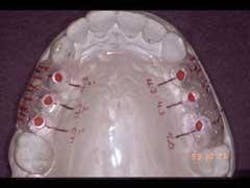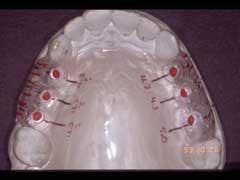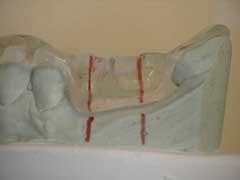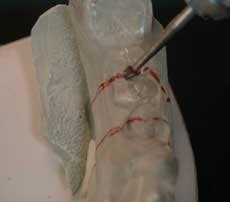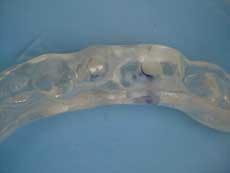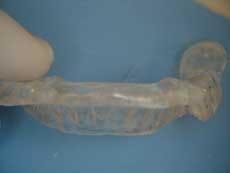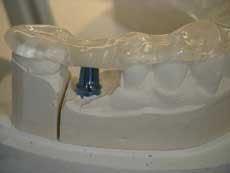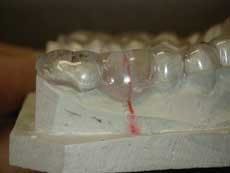The 3-way appliance for posterior implant restoration
Samuel M. Strong, DDS
The use of a template, or guide, for the surgical placement of implants is commonly advocated to maximize the accuracy of implant site and angulation. Various designs and methods of fabrication can be employed to produce this surgical template. Typically, the appliance is constructed of a solid acrylic material with holes drilled through the replicated coronal tooth structures indicating the ideal position for each implant (Fig. 1).
The template often is used only at the time of surgery and discarded thereafter. The patient continues to use either a temporary fixed or removable appliance while the implant integrates and until the final implant restoration is installed. Since the patient may never actually see the template, its cost-effectiveness or usefulness may not be readily apparent.
Although many cases require some form of provisionalization for function and aesthetics, I have found that this is not always necessary. For example, mandibular posterior single and double implant cases may be difficult to provisionalize with an interim removable partial denture without adding unnecessary bulk to the lingual areas and irritation from clasps. Although the patient may find it unpleasant to use the appliance, the restorative dentist may insist on its use to prevent collapse of adjacent teeth over the newly placed implant. For these reasons, the patient can be supplied with an appliance that serves the multiple purposes of a space maintainer, surgical template, and occlusal splint — the "Three-Way Implant Appliance." This niche application is most commonly used in posterior single-tooth implant cases, but can be applied to two or more implant sites in noncosmetic areas. One of the attractive features to the patient is the use of three appliances for the cost of one.
Case study
In the featured case, the patient has lost teeth Nos. 19 and 20 that are to be replaced with two dental implants. Alginate impressions of both arches and a bite registration were taken. The dental laboratory placed a denture tooth and wax thickness to simulate lingual coverage.
After I app-roved it, this denture tooth and wax-up were replicated in clear processed acrylic in a conventional pack-and-flask technique for denture fabrication (Fig. 2). The appliance was constructed to replicate the ideal contours and occlusal table desired in the final implant crown as well as full occlusal coverage of all the teeth in typical occlusal splint design. In addition to serving as a surgical implant template and occlusal splint, the appliance also is used as a space maintainer. In many cases, replacing a single posterior tooth where aesthetics and function are not concerns in the short term, the appliance is only needed for wear during sleeping periods to preserve the edentulous space for final implant crown dimensions.
In cases where extraction and implant placement are done at separate appointments, the appliance is delivered as soon as possible after tooth extraction. This appliance insertion is usually done within two to 10 days to fulfill its first purpose as a space maintainer. The patient's occlusion with the appliance inserted is adjusted as needed to provide bilateral and anterior-posterior points of contact with the opposing dentition. The patient is instructed to wear the Three-Way during sleep and advised that failure to do so can result in collapse of the adjacent teeth that could, in turn, compromise the final dimensions of the implant crown. In extreme cases, significant movement of the adjacent teeth can result in a nonrestorable condition or one requiring orthodontic repositioning of the adjacent teeth.
The day before placement of the implant, the patient returns to the restorative dentist for the pilot hole to be drilled through the template target. I use a No. 8 round carbide bur to initiate the hole, and then enlarge it to about a 3-mm diameter using a laboratory carbide drill (Universal Cutter, Axis Dental, Irving, Tex.) (Fig. 3). The template is either returned to the patient or delivered to the surgical dentist's office. The implant site and angulation are guided by the template, which is then returned to the restorative office following implant placement.
In most cases, the Three-Way can be returned to use as a space maintainer within a week after implant placement. The hole or holes used for implant placement are then filled with light-cured composite (Fig. 4). If a healing abutment is placed through the gingival tissues in a typical one-stage technique, the acrylic in this area is reamed out to accommodate full seating of the appliance. Occlusal contacts and appliance retention are reconfirmed by the restorative dentist.
The appliance is used in this fashion during sleeping periods as a space maintainer throughout the prosthetic procedures until the definitive crown(s) are delivered (Fig. 5). In some cases, the acrylic over the new implant crown can be reamed out sufficiently for continued use as a long-term occlusal splint. Should this application be desired, the laboratory must construct the appliance with sufficient thickness to prevent breakage upon these internal acrylic reductions. The occlusal surface of the Three-Way also can be constructed with anterior disclusion ramps in the cuspid areas if the clinician desires this feature (Fig. 6).
The fabrication of a template for implant placement should be done on any implant case. Even if a tooth is to be removed and immediately replaced with an implant in its original socket, the use of the template is a valuable tool by providing the surgical dentist with a visual and functional guide for ideal centering of the implant mesiodistally and buccolingually, as well as the correct angulation as it emerges through the gingival crest. This attention to detail improves the chances for restoring the implant with a straight abutment for cementation versus an angled abutment. This allows for force transmission closer to the longitudinal axis of the implant and reduces off-axis loading. Economically, this also reduces restorative costs. Premachined, straight abutments typically cost less than premachined angled abutments or custom abutments.
Fig. 7 illustrates a modification of a Three-Way in a case with immediate placement of both implant and final abutment following the extraction of tooth No. 30 (Easy Abutment, Nobel Biocare, Yorba Linda, Calif). The Three-Way is modified by sufficiently reaming out the acrylic tooth replication to accommodate the abutment height and contour.
An alternative and somewhat more economical option to the previously shown appliances constructed with processed acrylic is shown in Fig. 8. This appliance can be made in the dental office using 0.080-inch thick vacuum/heat-formed material (Ministar, Great Lakes Prostho-dontics, Tonawanda, N.Y.) filled with clear orthodontic resin (Dentsply Caulk, Milford, Del.) in the implant site. This provides a clear, solid replica of the proposed implant crown for drilling the template hole, as well as full occlusal coverage. To fulfill the role of an occlusal splint, however, the occlusal surfaces of the appliance will require application of more orthodontic resin on mounted models or intraorally to produce bilateral and anterior-posterior contacts with the opposing teeth.
I consider posterior single or multiple implant crowns to be the most productive procedure done in restorative dentistry. With proper planning, implant site preparation, and correct placement, there are few complications or contingencies relative to implant restorations in other critically cosmetic areas. Nevertheless, failure to protect against collapse of teeth into an implant site can turn a straightforward and highly predictable procedure into a poor result and a disappointed patient. The scenarios described in this article preclude this from happening in addition to giving patients the value-added benefit of multiple uses from a single appliance.
